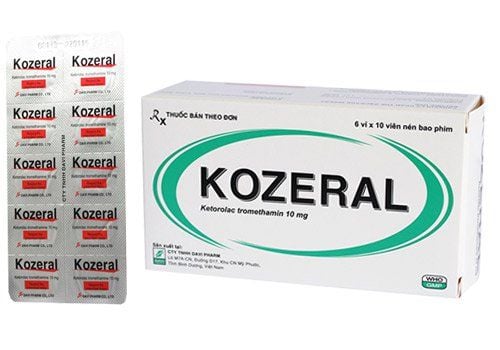This is an automatically translated article.
Kozeral 10mg contains ketorolac which is a medication used to manage and treat moderate to severe acute pain. This is one of the drugs in the group of non-steroidal anti-inflammatory drugs. Accordingly, patients need to use Kozeral 10mg for the right purpose, in accordance with the indications to achieve optimal pain relief and limit side effects.
1. Uses of the drug kozeral
Uses kozeral medicine is often used to relieve pain after surgery. When combined with opioids, ketorolac significantly reduces the need for opioids and reduces the incidence of adverse events such as vomiting and decreased gastrointestinal motility.
In pediatric subjects, ketorolac was as effective as the primary opioid analgesic. Therefore, kozeral 10mg is not an appropriate alternative or adjunct to pain management for children or adults with concerns about opioid dependence.
In the emergency department, kozeral is very effective in the treatment of musculoskeletal pain, migraine headaches as well as in the relief of pain caused by cancer that has spread to the bones.
2. Mechanism of action of the drug kozeral 10mg
The exact mechanism of kozeral 10mg or ketorolac is unknown. With pharmacological data, Ketorolac, like other NSAIDs, acts through the blocking of cyclooxygenase (COX), the enzymes that convert arachidonic acid to prostaglandins, prostacyclin and thromboxane. Inhibition of these substances reduces pain, fever, and inflammatory responses. Because ketorolac is able to inhibit both cyclooxygenase-1 and cyclooxygenase-2, this product has demonstrated superior potency over most other NSAIDs.

Kozeral 10mg được ứng dụng trong quản lý các cơn đau cấp tính
3. How to use Kozeral 10mg
The use of kozeral 10mg or ketorolac can be done orally, by nasal spray, intravenously or intramuscularly. In particular, the oral route should be used only after intravenous or intramuscular ketorolac has achieved relative pain control effect. In addition, the duration of ketorolac should not be prolonged for more than five days because of the increased risk of cardiac thrombotic events, renal failure, peptic ulcer disease and increased risk of bleeding multiple times.
3.1. Dosage for adults The recommended adult intravenous and intramuscular dose is 30 mg as a single dose or 30 mg every 6 hours, not to exceed 120 mg in 24 hours. The recommended oral dose in adults is 20 mg as a single dose following intravenous or intramuscular therapy, then 10 mg every 4 to 6 hours, not to exceed 40 mg in 24 hours. Half-life: 5.6 hours for 30 mg IM or 10 mg orally 3.2. Dosage for children Children under 2 years old is not recommended Children 2 to 16 years old: Single dose: 0.5 mg/kg intravenously or intramuscularly once; not more than 15 mg. Repeat dose: 0.5 mg/kg IV or IM every 6 hours; no more than 5 days Children over 16 years, under 50kg: Intravenous: 15 mg as a single dose or 15 mg every 6 hours; do not exceed 60 mg/day. Intramuscular: 30 mg as a single dose or 15 mg every 6 hours; do not exceed 60 mg/day. Oral administration: 10 mg once after intravenous or intramuscular treatment, then 10 mg every 6 hours; not to exceed 40 mg/day Over 16 years old, weighing more than 50 kg: Same as adults
4. Possible side effects when taking kozeral 10mg
Like other NSAIDs, kozeral 10mg or ketorolac has been shown to be associated with significant gastrointestinal, renal, and cardiovascular risks.
In the digestive system, kozeral 10mg may cause peptic ulcer and/or perforation of the stomach or intestines. In an extensive pooled data set, all NSAIDs, including COX2 inhibitors, were shown to increase the relative risk for peptic ulcer disease, with ketorolac occurring most frequently. . Furthermore, because of its inherent antiplatelet properties, ketorolac increases the risk of gastrointestinal bleeding or the risk of postoperative bleeding when compared with opioids. Ketorolac may increase the risk of cardiovascular thrombotic events, myocardial infarction, and hemorrhagic stroke. Heart failure is a significant risk factor for NSAID side effects. Finally, ketorolac can also cause kidney damage and failure. The above adverse events are significantly increased when used at higher doses, for periods of more than five days, and in patients over 75 years of age.

Thuốc Kozeral 10mg có thể gây ra một số tác dụng phụ cho người sử dụng
5. Contraindications before taking the drug kozeral 10mg
Kozeral 10mg or ketorolac is contraindicated in people who have had an adverse reaction or allergy to NSAIDs. Accordingly, kozeral 10mg is not recommended for intraoperative or preoperative administration due to the increased risk of bleeding. Besides, the drug kozeral 10mg is not recommended during labor and delivery, because it has a negative effect on fetal circulation and reduces uterine contractions.
In patients with renal disease or renal failure, ketorolac is contraindicated because it may increase fluid retention and worsen renal function. Gastrointestinal-related contraindications to ketorolac include patients with active peptic ulcer disease, recent gastrointestinal bleeding, or perforations in the gastrointestinal tract.
Finally, extreme caution should be exercised when ketorolac is used in the elderly and debilitated because severe adverse events can occur simultaneously on multiple organ systems.
Because of the increased risk of bleeding as a side effect, patients should be closely monitored for gastrointestinal bleeding during treatment with a complete blood count at baseline and periodic follow-up. Also, because kozeral 10mg is primarily metabolized in the liver, liver function tests should be checked at baseline and monitored frequently, especially in patients with liver damage. On the other hand, assessment of renal function is necessary through creatinine and urine output before taking this drug and monitoring it closely, as ketorolac is excreted by the kidneys and can cause kidney damage.
In a nutshell, kozeral 10mg contains ketorolac which is a non-steroidal anti-inflammatory drug (NSAID). The use of kozeral is to reduce the hormones that cause inflammation and pain in the body. Because side effects can be very dangerous, Kozeral 10mg should only be used short-term (5 days or less) to treat moderate to severe pain, in rheumatoid arthritis, osteoarthritis, spondylitis, and spondylitis. ankylosing spondylitis, dysmenorrhea and headache effectively and safely for patients.
Please dial HOTLINE for more information or register for an appointment HERE. Download MyVinmec app to make appointments faster and to manage your bookings easily.













